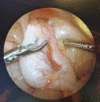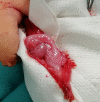Gubernaculum and Epididymo-Testicular Descent: Review of the Literature
- PMID: 37733393
- PMCID: PMC9799001
- DOI: 10.15388/Amed.2022.29.2.6
Gubernaculum and Epididymo-Testicular Descent: Review of the Literature
Abstract
Cryptorchidism is a common disorder in boys that has been widely studied both experimentally and clinically. The role of the gubernaculum, a mesenchymal tissue extending from the fetal testis and epididymis to the developing scrotum, is still unclear. Even the name is debated: 'gubernaculum epididymis' or 'gubernaculum testis'. This review does not aim to provide a global overview of competing theories on testicular descent, but focuses on the role of the gubernaculum in epididymo-testicular descent. We identified four major pitfalls of gubernaculum research: the role of the gubernaculum, of insulin-like peptide 3, anti-Müllerian hormone, and androgens. The major critical issues were that the gubernaculum plays a guiding role for the epididymis, descending prior to the testis and expanding the inguinal canal; insulin-like peptide 3 is not as important for the process of descent in humans as the rate of insulin-like peptide 3 mutations is low; anti-Müllerian hormone plays no significant role in epididymo-testicular descent; androgens and gonadotropins play a crucial role in epididymo-testicular descent. The role of the epididymis in the complex process of gubernaculum, epididymis, and testis migration is underestimated and should be included in future research.
Nunusileidusios sėklidės (kriptorchizmas) yra dažna vyriškų lytinių organų patologija. Sėklidės pavadis (lot. gubernaculum testis) – mezenchiminis audinys tarp vaisiaus sėklidės ir prielipo bei besiformuojančio kapšelio. Jo reikšmė sėklidei ir prielipui nusileisti nėra aiški. Šios apžvalgos tikslas nėra įvertinti vienų kitoms prieštaraujančių sėklidės nusileidimo teorijų, o susitelkiama ties sėklidės pavadžio (ar dar kitaip vadinamo prielipo pavadžio) svarba sėklidei nusileisti. Mes kėlėme šiuos pagrindinius klausimus apie sėklidės pavadį: sėklidės pavadžio svarba, į insuliną panašaus hormono 3, antimiulerinio hormono ir androgenų reikšmė. Sėklidės pavadis atlieka tik orientacinį vaidmenį prielipui ir leidžiasi prieš sėklidę plėsdamas kirkšnies kanalą. Į insuliną panašus hormonas nėra svarbus sėklidei nusileisti, nes žmonių populiacijos šio geno mutacijos yra retos. Antimiulerinis hormonas neatlieka reikšmingo vaidmens, kad sėklidė ir prielipas nusileistų. Androgenai ir gonadotropinai yra svarbiausi, kad įvyktų sėklidės ir prielipo nusileidimas. Prielipo reikšmė sudėtingame pavadžio, prielipo ir sėklidės migracijos procese yra nepakankamai įvertinta.
Keywords: Insl3; cryptorchidism; epididymo-testicular descent; gubernaculum.
Copyright © 2022 Eleonora Ivanova, Beata Vincel, Gilvydas Verkauskas, Faruk Hadziselimovic. Published by Vilnius University Press.
Conflict of interest statement
The authors have no conflicts of interest to declare.
Figures
Similar articles
-
The gubernaculum during testicular descent in the human fetus.J Anat. 1987 Aug;153:93-112. J Anat. 1987. PMID: 2892824 Free PMC article.
-
In vitro model of the first phase of testicular descent: identification of a low molecular weight factor from fetal testis involved in proliferation of gubernaculum testis cells and distinct from specified polypeptide growth factors and fetal gonadal hormones.Endocrinology. 1988 Dec;123(6):2868-77. doi: 10.1210/endo-123-6-2868. Endocrinology. 1988. PMID: 3058462
-
Role of the gubernaculum and intraabdominal pressure in the process of testicular descent.J Urol. 1984 Mar;131(3):574-9. doi: 10.1016/s0022-5347(17)50507-8. J Urol. 1984. PMID: 6700007
-
Role of Gubernaculum testis inervation during the process of testicular migration in human fetuses.Int Braz J Urol. 2024 Sep-Oct;50(5):519-529. doi: 10.1590/S1677-5538.IBJU.2024.9914. Int Braz J Urol. 2024. PMID: 39059017 Free PMC article. Review.
-
Factors controlling testis descent.Eur J Endocrinol. 2008 Dec;159 Suppl 1:S75-82. doi: 10.1530/EJE-08-0458. Epub 2008 Jul 22. Eur J Endocrinol. 2008. PMID: 18647820 Review.
Cited by
-
Anti-Müllerian hormone, testicular descent and cryptorchidism.Front Endocrinol (Lausanne). 2024 Mar 4;15:1361032. doi: 10.3389/fendo.2024.1361032. eCollection 2024. Front Endocrinol (Lausanne). 2024. PMID: 38501100 Free PMC article. Review.
References
-
- Hunter J. A description of the fituation of the testis in the foetus, with its decent into the scrotum. In: Observations on Certain Parts of the Animal Oeconomy. Philadelphia: Haswell, Barrington; 1786. p. 1–261.
-
- Seiler BW. Observationes nonnullae de testiculorum ex abdomine in scrotum descensu et partium genitalium anomaliis. G. Engelmann; 1817.
-
- Cleland, John. The mechanism of the gubernaculum testis : with an introductory sketch of the development of the testes, and an appendix on the purpose of their descent from the abdomen. Edinburgh; 1856.
-
- Weil C. Ueber den Descensus testiculorum: nebst Bemerkungen uebeer die Entwickelung der Scheidenhaute und des Scrotums. Leipzig; 1885.
Publication types
LinkOut - more resources
Full Text Sources


